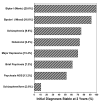McLean-Harvard International First-Episode Project: two-year stability of DSM-IV diagnoses in 500 first-episode psychotic disorder patients
- PMID: 19200422
- PMCID: PMC2713192
- DOI: 10.4088/jcp.08m04227
McLean-Harvard International First-Episode Project: two-year stability of DSM-IV diagnoses in 500 first-episode psychotic disorder patients
Abstract
Objective: Since stability of DSM-IV diagnoses of disorders with psychotic features requires validation, we evaluated psychotic patients followed systematically in the McLean-Harvard International First Episode Project.
Method: We diagnosed 517 patients hospitalized in a first psychotic illness by SCID-based criteria at baseline and at 24 months to assess stability of specific DSM-IV diagnoses.
Results: Among 500 patients (96.7%) completing the study, diagnoses remained stable in 77.6%, ranking as follows: bipolar I disorder (96.5%) > schizophrenia (75.0%) > delusional disorder (72.7%) > major depressive disorder (MDD), severe, with psychotic features (70.1%) > brief psychotic disorder (61.1%) > psychotic disorder not otherwise specified (NOS) (51.5%) >> schizophreniform disorder (10.5%). Most changed diagnoses (22.4% of patients) were to schizoaffective disorder (53.6% of changes in 12.0% of subjects, from psychotic disorder NOS > schizophrenia > schizophreniform disorder = bipolar I disorder most recent episode mixed, severe, with psychotic features > MDD, severe, with psychotic features > delusional disorder > brief psychotic disorder > bipolar I disorder most recent episode manic, severe, with psychotic features). Second most changed diagnoses were to bipolar I disorder (25.9% of changes, 5.8% of subjects, from MDD, severe, with psychotic features > psychotic disorder NOS > brief psychotic disorder > schizophreniform disorder). Third most changed diagnoses were to schizophrenia (12.5% of changes, 2.8% of subjects, from schizophreniform disorder > psychotic disorder NOS > brief psychotic disorder = delusional disorder = MDD, severe, with psychotic features). These 3 categories accounted for 92.0% of changes. By logistic regression, diagnostic change was associated with nonaffective psychosis > auditory hallucinations > youth > male sex > gradual onset.
Conclusions: Bipolar I disorder and schizophrenia were more stable diagnoses than delusional disorder or MDD, severe, with psychotic features, and much more than brief psychotic disorder, psychotic disorder NOS, or schizophreniform disorder. Diagnostic changes mainly involved emergence of affective symptoms and were predicted by several premorbid factors. The findings have implications for revisions of DSM and ICD.
©Copyright 2009 Physicians Postgraduate Press, Inc.
Figures

Similar articles
-
McLean-Harvard International First-Episode Project: two-year stability of ICD-10 diagnoses in 500 first-episode psychotic disorder patients.J Clin Psychiatry. 2011 Feb;72(2):183-93. doi: 10.4088/JCP.09m05311yel. Epub 2010 Jul 13. J Clin Psychiatry. 2011. PMID: 20673546 Free PMC article.
-
Predicting diagnostic change among patients diagnosed with first-episode DSM-IV-TR major depressive disorder with psychotic features.J Clin Psychiatry. 2013 Jul;74(7):723-31; quiz 731. doi: 10.4088/JCP.12m08328. J Clin Psychiatry. 2013. PMID: 23945450
-
The McLean-Harvard First-Episode Project: Early Course in 114 Cases of First-Episode Nonaffective Psychoses.J Clin Psychiatry. 2016 Jun;77(6):781-8. doi: 10.4088/JCP.14m09414. J Clin Psychiatry. 2016. PMID: 27232651
-
Psychotic symptoms in pediatric bipolar disorder.J Affect Disord. 2004 May;80(1):19-28. doi: 10.1016/S0165-0327(03)00053-3. J Affect Disord. 2004. PMID: 15094254 Review.
-
Chronic hallucinatory psychosis, bouffée délirante, and the classification of psychosis in French psychiatry.Curr Psychiatry Rep. 2003 Jul;5(3):187-91. doi: 10.1007/s11920-003-0040-2. Curr Psychiatry Rep. 2003. PMID: 12773270 Review.
Cited by
-
Dissimilar morbidity following initial mania versus mixed-states in type-I bipolar disorder.J Affect Disord. 2010 Oct;126(1-2):299-302. doi: 10.1016/j.jad.2010.03.014. Epub 2010 Apr 27. J Affect Disord. 2010. PMID: 20427091 Free PMC article.
-
Role of paliperidone extended-release in treatment of schizoaffective disorder.Neuropsychiatr Dis Treat. 2010 Oct 5;6:667-79. doi: 10.2147/NDT.S12612. Neuropsychiatr Dis Treat. 2010. PMID: 20957127 Free PMC article.
-
Narrative identity in the psychosis spectrum: A systematic review and developmental model.Clin Psychol Rev. 2021 Aug;88:102067. doi: 10.1016/j.cpr.2021.102067. Epub 2021 Jul 10. Clin Psychol Rev. 2021. PMID: 34274799 Free PMC article.
-
Delusional disorders--are they simply paranoid schizophrenia?Schizophr Bull. 2012 May;38(3):561-8. doi: 10.1093/schbul/sbq125. Epub 2010 Nov 15. Schizophr Bull. 2012. PMID: 21078814 Free PMC article.
-
First-episode psychosis: How long does it last? A review of evolution and trajectory.Ind Psychiatry J. 2021 Jul-Dec;30(2):198-206. doi: 10.4103/ipj.ipj_38_21. Epub 2021 Jul 20. Ind Psychiatry J. 2021. PMID: 35017801 Free PMC article. Review.
References
-
- Kahlbaum KL. In: Catatonia (1874) Levij Y, Pridan T, translators. Baltimore, MD: Johns Hopkins University Press; 1973.
-
- Kraepelin E. In: Psychiatrie: Ein Lehrbuch für Studierende und Ärzte [Textbook of Psychiatry. Leipzig: JA Barth, 1913] Barclay RM, translator. Edinburgh: E & S Livingstone; 1919.
-
- Robins E, Guze SB. Establishment of diagnostic validity in psychiatric illness: application to schizophrenia. Am J Psychiatry. 1970;126:983–937. - PubMed
-
- American Psychiatric Association (APA) Diagnostic and Statistical Manual of Mental Disorders. fourth. Arlington, VA: American Psychiatric Press; 2000. text revision (DSM-IV-TR)
-
- International Classification of Diseases, tenth revision (ICD-10) World Health Organization (WHO); Geneva: WHO; 1992.
Publication types
MeSH terms
Grants and funding
LinkOut - more resources
Full Text Sources
Medical

